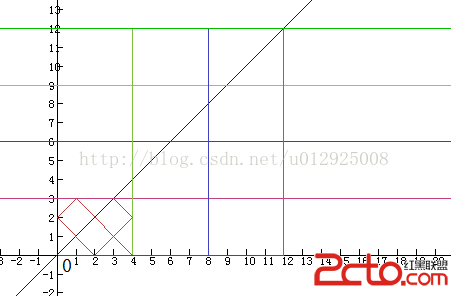Time Limit: 1 secs, Memory Limit: 32 MB
There is a rectangular pool table ABCD with side lengths m and n, where m and n are integers with m
B---------C
| |
| |
A---------D
Input consist of mutiple cases. Each case include two integers m and n, both of which fits in 32-bit signed integer.
For each case, you should find out which pocket (A,B,C,D) the ball first hit and how many reflections the ball make .
6 10
C 6
假設球撞到邊界時不會反彈,而是繼續進入下一個與原圖一樣大小的邊界,那麼,由於出發的角度是45度,經過了m,n的公倍數的時候就會撞擊一次洞,第一次撞擊自然就是最小公倍數了(這樣的話其實30度60度也是同樣的思路)。見下圖:

上圖已經顯示得很清晰了,這樣,我們只需計算出最小公倍數,然後計算撞擊橫邊和縱邊的次數,最後再根據撞擊次數確定洞就行:
#includeint gcd(int a, int b) {//求最大公約數不用遞歸會快 int c = a % b; while (c != 0) { a = b; b = c; c = a % b; } return b; } int main() { int n, m, lcm, hit_horizontal_size, hit_vertical_size; while (~scanf("%d%d", &m, &n)) { lcm = n * m / gcd(n, m); hit_horizontal_size = lcm / m - 1;//注意由於最後到洞的時候是不算撞邊的,所以都要減去一 hit_vertical_size = lcm / n - 1; //1 & 1 = 1, 0 & 1 = 0,判斷奇偶這樣快 if (hit_horizontal_size & 1) {//如果撞擊水平邊的次數是奇數次,那麼可能的點是AD if (hit_vertical_size & 1) {//如果撞擊豎直邊的次數是奇數次,那麼可能的點是AB printf("A "); } else { printf("D "); } } else { if (hit_vertical_size & 1) { printf("B "); } else { printf("C "); } } printf("%d\n", hit_horizontal_size + hit_vertical_size); } return 0; }